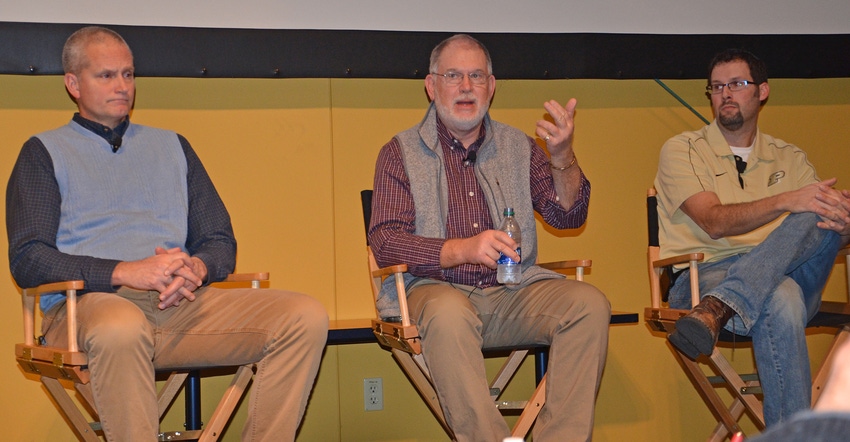
Three Purdue University Extension specialists opened the floor at the Purdue Top Farmer conference and invited questions. As you might imagine, some questions related to the situation in 2019, and what could be expected in 2020.
Jim Mintert, director of the Purdue Center for Commercial Agriculture, turned the packed house loose on the experts: Bob Nielsen, Extension corn specialist; Shaun Casteel, Extension soybean specialist; and Bill Johnson, Extension weed control specialist.
What did we learn about planting dates for corn in 2019?
Nielsen: The year turned out to be a classic reminder that planting date is only one of many variables which control corn yield. The last trial we harvested at the Throckmorton Ag Research Center in early December was planted June 3, yet it averaged 224 bushels per acre dry corn, with harvest moisture still at 21%. Anecdotal evidence from farmers last year and in other years indicates that corn planted in early June can yield well over 200 bushels per acre given the right weather conditions during the rest of the season.
Does the risk go up when you plant that late? Yes, of course. But consider this: Planting progress for corn in Indiana was one of the three slowest in the last 40 years in 2019, similar to 1981 and 1996. Indiana had the most prevented planting acres ever. Weekly crop progress reports of crop condition were the fourth worst in 34 years. Yet according to the January USDA estimates, Indiana’s final 2019 average yield of 169 bushels per acre is only 2.5% below the trend yield of 173.4 bushels per acre.
What is the take-home message for soybeans from 2019?
Casteel: There are several. What happened in 2019 started setting up in the fall of 2018, following a record Indiana average soybean yield of 57.5 bushels per acre. The fall of ’18 turned wet. Some were still harvesting those beans in January 2019. Fertilizer didn’t always get applied as it should have, fall herbicide applications didn’t go on, and ruts were still there for spring. Some are still there. That means there is soil compaction in many fields.
As Bob [Nielsen] says, soil compaction is the gift that keeps on giving. Sometimes we can’t avoid it, but we need to think about things like improving soil drainage when possible. The bottom line is what you do in one season, even in the fall, can affect the next year.
Is there another lesson for soybeans from 2019?
Casteel: Yes, base decisions in-season on what plants are doing, not the calendar. For example, we recommend applying fungicides at the R3 growth stage in soybeans. The R3 stage is always the R3 stage — don’t base what you do on the calendar. Base it on what the crop is telling you.
What could we use as a long-lasting residual herbicide for soybeans?
Johnson: We need longer residual control for waterhemp and giant ragweed, since they can germinate well into the season. For waterhemp, if you can apply a residual herbicide before soybeans emerge, I would consider something with Authority or Valor in it. Then I would put another layer of residual down later. Zidua is a good choice as a residual for waterhemp when applied with the postemergence application.
Editor’s note: This is the first in a three-part series of answers to tough crop questions. Watch for the next installment tomorrow.
About the Author(s)
You May Also Like




